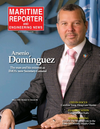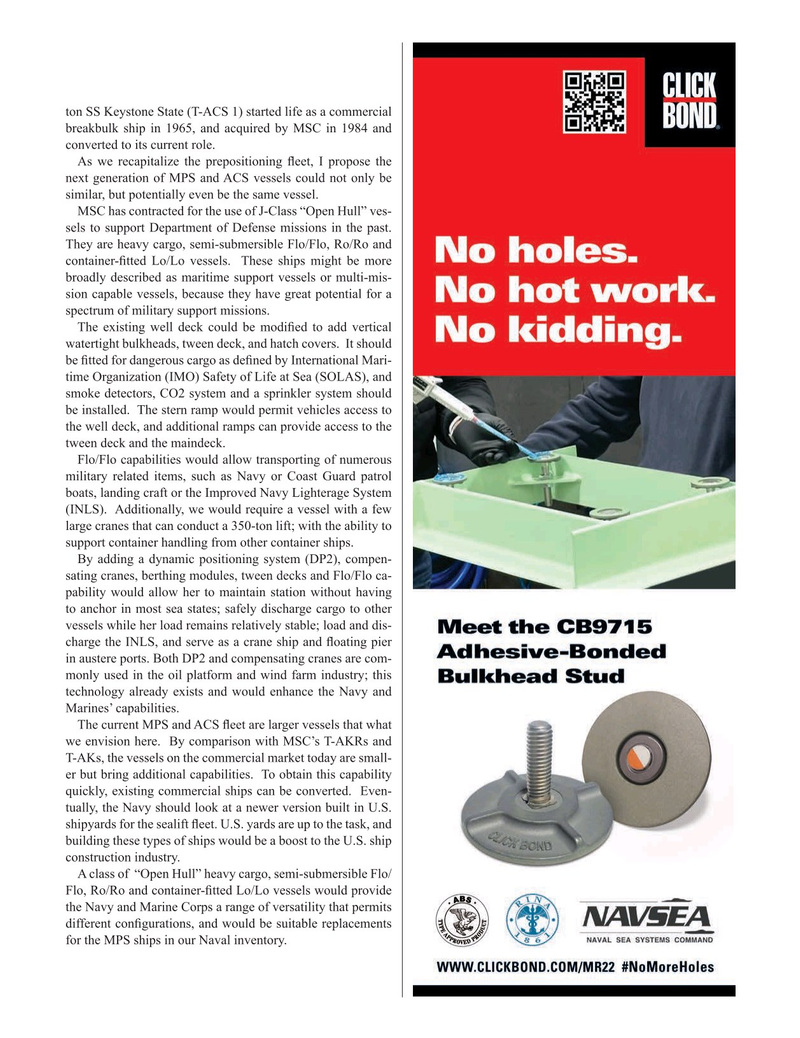
Page 13: of Maritime Reporter Magazine (May 2024)
Read this page in Pdf, Flash or Html5 edition of May 2024 Maritime Reporter Magazine
ton SS Keystone State (T-ACS 1) started life as a commercial breakbulk ship in 1965, and acquired by MSC in 1984 and converted to its current role.
As we recapitalize the prepositioning ? eet, I propose the next generation of MPS and ACS vessels could not only be similar, but potentially even be the same vessel.
MSC has contracted for the use of J-Class “Open Hull” ves- sels to support Department of Defense missions in the past.
They are heavy cargo, semi-submersible Flo/Flo, Ro/Ro and container-? tted Lo/Lo vessels. These ships might be more broadly described as maritime support vessels or multi-mis- sion capable vessels, because they have great potential for a spectrum of military support missions.
The existing well deck could be modi? ed to add vertical watertight bulkheads, tween deck, and hatch covers. It should be ? tted for dangerous cargo as de? ned by International Mari- time Organization (IMO) Safety of Life at Sea (SOLAS), and smoke detectors, CO2 system and a sprinkler system should be installed. The stern ramp would permit vehicles access to the well deck, and additional ramps can provide access to the tween deck and the maindeck.
Flo/Flo capabilities would allow transporting of numerous military related items, such as Navy or Coast Guard patrol boats, landing craft or the Improved Navy Lighterage System (INLS). Additionally, we would require a vessel with a few large cranes that can conduct a 350-ton lift; with the ability to support container handling from other container ships.
By adding a dynamic positioning system (DP2), compen- sating cranes, berthing modules, tween decks and Flo/Flo ca- pability would allow her to maintain station without having to anchor in most sea states; safely discharge cargo to other vessels while her load remains relatively stable; load and dis- charge the INLS, and serve as a crane ship and ? oating pier in austere ports. Both DP2 and compensating cranes are com- monly used in the oil platform and wind farm industry; this technology already exists and would enhance the Navy and
Marines’ capabilities.
The current MPS and ACS ? eet are larger vessels that what we envision here. By comparison with MSC’s T-AKRs and
T-AKs, the vessels on the commercial market today are small- er but bring additional capabilities. To obtain this capability quickly, existing commercial ships can be converted. Even- tually, the Navy should look at a newer version built in U.S. shipyards for the sealift ? eet. U.S. yards are up to the task, and building these types of ships would be a boost to the U.S. ship construction industry.
A class of “Open Hull” heavy cargo, semi-submersible Flo/
Flo, Ro/Ro and container-? tted Lo/Lo vessels would provide the Navy and Marine Corps a range of versatility that permits different con? gurations, and would be suitable replacements for the MPS ships in our Naval inventory.
MR #5 (1-17).indd 13 5/3/2024 10:09:40 AM

 12
12

 14
14
